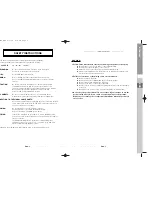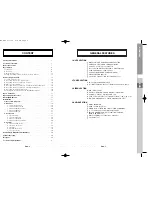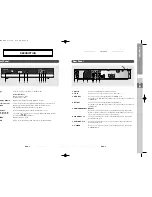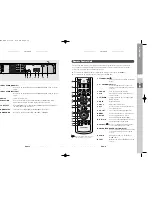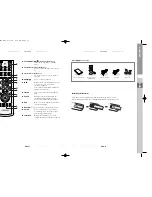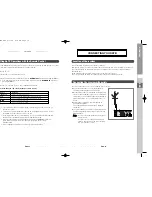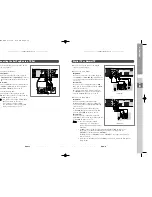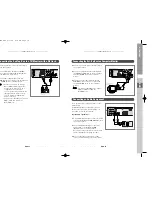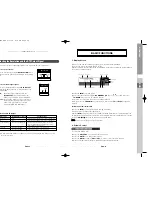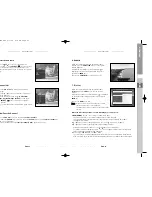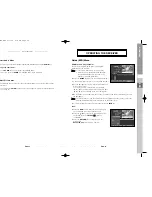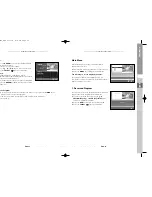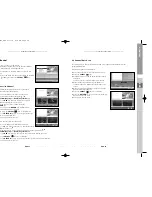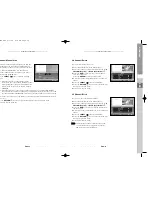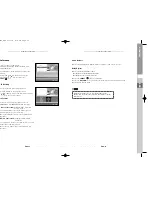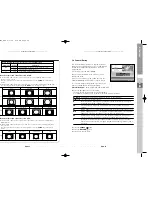
DTB-H550F
ENG-5
ENG
DTB-H550F
TECHNICAL OVERVIEW
ENG-4
D
I
G
I
T
A
L
T
E
R
R
E
S
T
R
I
A
L
H
D
T
V
R
E
C
E
I
V
E
R
What are SDTV and HDTV?
SDTV
SDTV is a digital TV format that provides a high quality picture at resolutions that can be displayed on
standard TV sets (see more on resolutions later in this chapter).
HDTV
HDTV is a digital TV format that provides the highest quality picture at resolutions that can be displayed on
computer monitors and HDTV-ready TV displays (see more on resolutions later in this chapter).
Resolution
Resolution refers to the number of pixels on the screen. The higher the resolution, the better the
visual quality.
Digital broadcasts are classified into HD and SD grades according to the visual quality. In general,
HD (High Definition) grade supports resolutions of 1920x1080i and 1280x720p and an aspect
ratio of 16:9 for both ATSC and DVB standards.
SD (Standard Definition) grade supports resolutions of 720x480p and 720x480i for the ATSC
standard, and supports resolutions of 720x576p and 720x576i for the DVB standard.
SD grade usually supports an aspect ratio of 4:3. However, it may differ depending on the region.
DVB-T(Terrestrial Digital Video Broadcasting)
What is DVB-T?
DVB-T is a European terrestrial digital broadcasting standard. DVB-T also refers to digital
broadcasting that complies with the DVB-T standard. The DVB-T standard has been developed
so that a digital broadcasting signal can be sent through the UHF/VHF channels that are currently
allocated for analog broadcasting channels. The advantages of this standard include robustness
against multi-path delay spread and SFN (Single Frequency Network) support. In addition, a
mobile user can receive the signal.
Aspect ratio
In addition to resolution, HDTV is also defined by the aspect ratio of its broadcasts.
Aspect ratio means the shape of the screen as defined by the ratio of the screen’s width to its
height. For analog TV and SDTV, the aspect ratio is 4 units wide by 3 units high (usually written 4:3).
This is the familiar shape of conventional TVs — slightly wider than they are tall.
For HDTV broadcasts, the aspect ratio is 16:9 (nearly twice as wide as it is tall).
This is, not coincidentally, more like the shape of movies shown in theaters.
This makes HDTV an ideal format for broadcasting and viewing movies on a TV.
But what happens if you are watching a nearly square-shaped 4:3 broadcast on a rectangular
16:9 TV, or vice-versa? The HD Receiver allows you to choose from a variety of screen formats
to help you deal with those scenarios.
Screen formats
To deal with the mismatches that can occur between the shapes of TVs and the aspect ratios of
program broadcasts, the HD Receiver provides you with a set of screen format controls.
These controls allow you to pick a format to use for both 4:3 TVs showing 16:9 programs, and for
16:9 TVs showing 4:3 programs.
Here is an explanation of the options. (Details for setting this preference are included in page 34.)
Dolby
®
Digital 5.1
Dolby Digital 5.1 provides 5 discrete channels of digital audio information for use by A/V receivers
capable of decoding the 5.1 channel signal.
The audio signals are broken into left-front, center, right-front, left-rear, right-rear and a
low-frequency effects channel (designed for subwoofers).
The result when connected to a compatible Dolby Digital 5.1 channel A/V receiver and speaker
setup is a home theater experience that provides much of the dynamic range, 360-degree imaging,
and sonic excitement of a real theater.
To take full advantage of the Dolby Digital 5.1 capabilities of the HD Receiver, you will need a
Dolby Digital 5.1 compatible A/V receiver connected to the HD Receiver through the Dolby Digital
Optical jack or the Dolby Digital Coaxial jack.
AC-3 is a sound encoding/decoding technology developed in 1987 for movie theatres and means
an AC-3 bit stream. AC-3 is used synonymously with Dolby Digital nowadays.
DVI (Digital Video Interface)
DVI is a video interface standard that directly outputs the digital video signal from a digital device
without converting the signal from analog to digital so as to provide a clearer picture by preventing
the degradation of the visual quality through the transmission and conversion operations.
There are 2 types of DVI cables.
DVI-D Cable: Used for digital signal transmission
DVI-I Cable: Used for digital and analog RGB signal transmission
TECHNICAL OVERVIEW
0401 DTB-H550F_ENG 4/1/05 3:18 PM Page 4


